量子力学课件(6)( 一维方势垒、隧道效应)
- 格式:ppt
- 大小:580.00 KB
- 文档页数:17

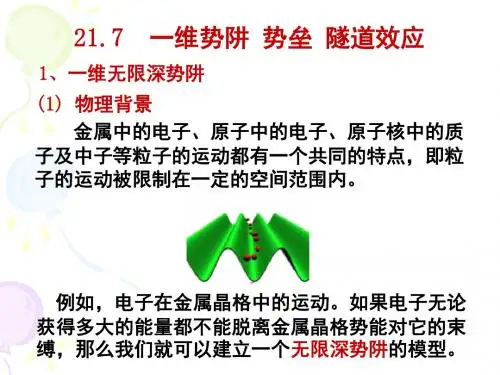
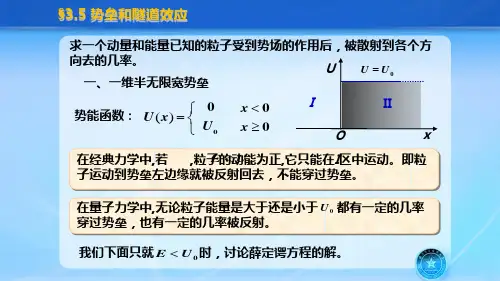
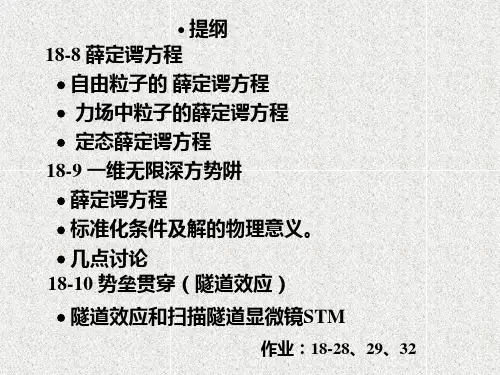
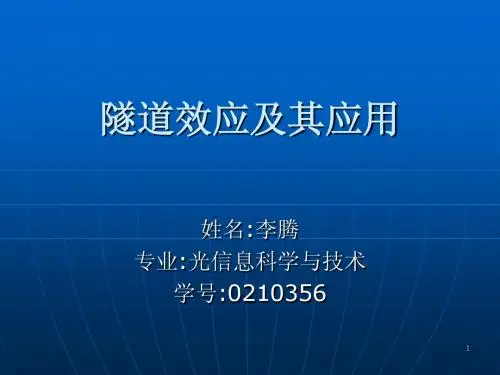
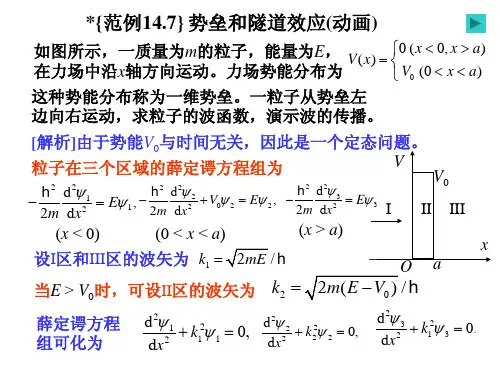
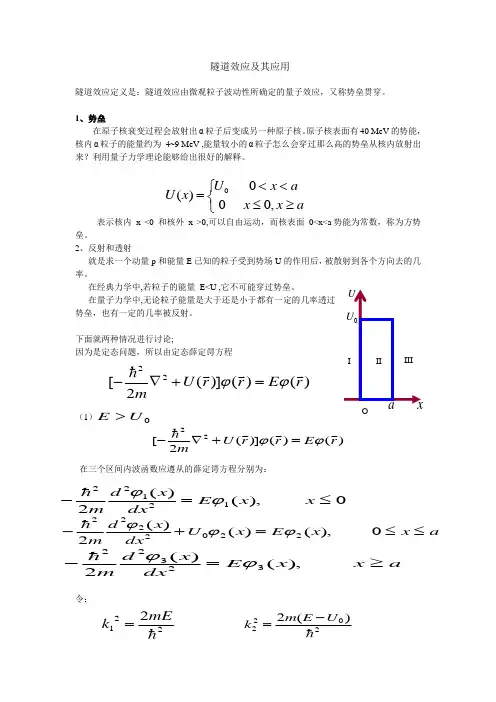

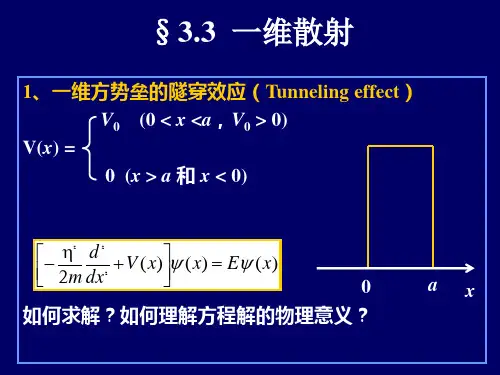

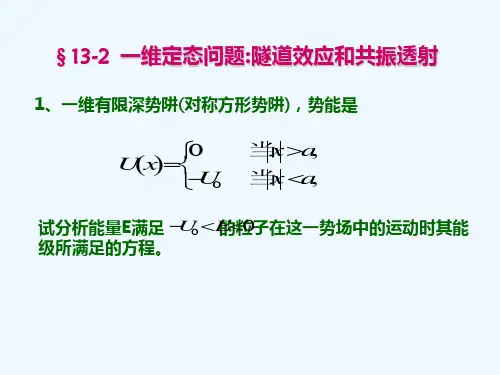
Lecture2Quantum mechanics in one dimensionQuantum mechanics in1d:Outline1Unbound statesFree particlePotential stepPotential barrierRectangular potential well2Bound statesRectangular potential well(continued)δ-function potential3Beyond local potentialsKronig-Penney model of a crystalAnderson localizationi ∂tΨ(x,t)=− 2∂2x2mΨ(x,t)For V=0Schr¨o dinger equation describes travelling waves.Ψ(x,t)=A e i(kx−ωt),E(k)= ω(k)= 2k2 2mwhere k=2πλwithλthe wavelength;momentum p= k=hλ.Spectrum is continuous,semi-infinite and,apart from k=0,has two-fold degeneracy(right and left moving particles).i ∂tΨ(x,t)=− 2∂2x2mΨ(x,t)Ψ(x,t)=A e i(kx−ωt)For infinite system,it makes no sense tofix wave function amplitude,A,by normalization of total probability.Instead,fix particleflux:j=−2m(iΨ∗∂xΨ+c.c.)j=|A|2 km=|A|2pmNote that definition of j follows from continuity relation,∂t|Ψ|2=−∇·jThe Fourier transform of a normalized Gaussian wave packet,ψ(x)= 12πα 1/4e ik0x e−x24α.(moving at velocity v= k0/m)is also a Gaussian,ψ(k)= 2απ 1/4e−α(k−k0)2,Although we can localize a wave packet to a region of space,this has been at the expense of having some width in k.For the Gaussian wave packet,∆x = [x − x ]2 1/2≡ x 2 − x 2 1/2=√α,∆k =1√4αi.e.∆x ∆k =12,constant.In fact,as we will see in the next lecture,the Gaussian wavepacket has minimum uncertainty ,∆p ∆x = 2Stationary form of Schr¨o dinger equation,Ψ(x,t)=e−iEt/ ψ(x):− 2∂2x2m+V(x) ψ(x)=Eψ(x)As a linear second order differential equation,we must specify boundary conditions on bothψand its derivative,∂xψ. As|ψ(x)|2represents a probablility density,it must be everywherefinite⇒ψ(x)is alsofinite. Sinceψ(x)isfinite,and E and V(x)are presumedfinite,so∂2xψ(x)must befinite.⇒bothψ(x)and∂xψ(x)are continuous functions of xFor E >V 0,both k <and k >=2m (E −V 0)are real,and j i = k <m,j r =|r |2 k <m,j t =|t |2 k >mDefining reflectivity,R ,and transmittivity,T ,R =reflected flux incident flux,T =transmitted flux incident flux R =|r |2=k <−k >k <+k >2,T =|t |2k >k <=4k <k >(k <+k >)2,R +T =1For E <V 0, k >=2m (E −V 0)becomes pure imaginary,wavefunction,ψ>(x ) te −|k >|x ,decays evanescently,andj i = k <m,j r =|r |2 k <m,j t =0Beam is completely reflected from barrier,R =|r |2= k <−k >k <+k >2=1,T =0,R +T =1Transmission across a potential barrier–prototype for generic quantum scattering problem dealt with later in the course. Problem provides platform to explore a phenomenon peculiar to quantum mechanics–quantum tunneling.Wavefunction parameterization:ψ1(x)=e ik1x+r e−ik1x x≤0ψ2(x)=A e ik2x+B e−ik2x0≤x≤aψ3(x)=t e ik1x a≤xwhere k1=√2mE and k2= 2m(E−V0).Continuity conditions onψand∂xψat x=0and x=a,1+r=A+BAe ik2a+Be−ik2a=te ik1a, k1(1−r)=k2(A−B)k2(Ae ik2a−Be−ik2a)=k1te ik1aSolving for transmission amplitude,t=2k1k2e−ik1a2k1k2cos(k2a)−i(k21+k22)sin(k2a)which translates to a transmissivity ofT=|t|2=11+14 k1k2−k2k1 2sin2(k2a) and reflectivity,R=1−T(particle conservation).but penetrates,barrier region–quantumUnbound particles:tunnelingAlthough tunneling is a robust,if uniquely quantum,phenomenon,it is often difficult to discriminate from thermal activation.Experimental realization provided by Scanning TunnelingMicroscope(STM)Quantum mechanical scattering in three-dimensions In three dimensions,plane wave can be decomposed intosuperposition of incoming and outgoing spherical waves: If V(r)short-ranged,scattering wavefunction takes asymptotic form,e i k·r=i2k∞ =0i (2 +1) e−i(kr− π/2)r−S (k)e i(kr− π/2)r P (cosθ)Quantum mechanics in1d:bound states1Rectangular potential well(continued)2δ-function potentialFor a potential well,we seek bound state solutions with energies lying in the range−V0<E<0.Symmetry of potential⇒states separate into those symmetric and those antisymmetric under parity transformation,x→−x. Outside well,(bound state)solutions have form√−2mE>0ψ1(x)=Ceκx for x>a, κ=In central well region,general solution of the formψ2(x)=A cos(kx)or B sin(kx), k= 2m(E+V0)>0Uncertainty relation,∆p∆x>h,shows that confinement by potential well is balance between narrowing spatial extent ofψwhile keeping momenta low enough not to allow escape.In fact,one may show(exercise!)that,in one dimension,arbitrarily weak binding always leads to development of at least one bound state.In higher dimension,potential has to reach critical strength to bind a particle.Forδ-function potential V(x)=−aV0δ(x),− 2∂2x2m−aV0δ(x) ψ(x)=Eψ(x)(Once again)symmetry of potential shows that stationary solutions of Schr¨o dinger equation are eigenstates of parity,x→−x.States with odd parity haveψ(0)=0,i.e.insensitive to potential.Quantum mechanics in1d:beyond local potentials1Kronig-Penney model of a crystal2Anderson localizationKronig-Penney model provides caricature of(one-dimensional) crystal lattice potential,∞ n=−∞δ(x−na)V(x)=aV0Since potential is repulsive,all states have energy E>0. Symmetry:translation by lattice spacing a,V(x+a)=V(x). Probability density must exhibit same translational symmetry, |ψ(x+a)|2=|ψ(x)|2,i.e.ψ(x+a)=e iφψ(x).In region(n−1)a<x<na,general solution of Schr¨o dinger equation is plane wave like,ψn(x)=A n sin[k(x−na)]+B n cos[k(x−na)]√2mEwith k=Imposing boundary conditions onψn(x)and∂xψn(x)and requiring ψ(x+a)=e iφψ(x),we can derive a constraint on allowed k values (and therefore E)similar to quantized energies for bound states.Rearranging equations(1)and(2),and using the relations A n+1=e iφA n and B n+1=e iφB n,we obtaincosφ=cos(ka)+maV02k sin(ka)Since cosφcan only take on values between−1and1,there are2k2Example:Naturally occuring photonic crystals “Band gap”phenomena apply to any wave-like motion in a periodicsystem including light traversing dielectric media,e.g.photonic crystal structures in beetles and butterflies!Band-gaps lead to perfect reflection of certain frequencies.Anderson localizationWe have seen that even a weak potential can lead to the formationof a bound state.However,for such a confining potential,we expect high energystates to remain unbound.Curiously,and counter-intuitively,in1d a weak extended disorderpotential always leads to the exponential localization of allquantum states,no matter how high the energy!First theoretical insight into the mechanism of localization wasachieved by Neville Mott!。
量子力学彭斌地址:微固楼211电话:83201475Email: bpeng@引言牛顿力学质点运动牛顿力学(F、p、a)22dtvdmmaF==牛顿力学成功应用到从天体到地上各种尺度的力学客体的运动中。
引言牛顿力学热力学●统计物理Ludwig Boltzmann Willard Gibbs引言牛顿力学热力学●统计力学 电动力学电磁现象——Maxwell方程组¾统一电磁理论¾光─> 电磁波1600170018001900时间t力学电磁学热学物理世界(力、光、电磁、热…)经典热力学(加上统计力学)经典电动力学(Maxwell 方程组)经典力学(牛顿力学)迈克尔逊-莫雷实验黑体辐射动力学理论断言,热和光都是运动的方式。
但现在这一理论的优美性和明晰性却被两朵乌云遮蔽,显得黯然失色了……——开尔文(1900年)引言什么是量子力学?什么是量子力学?——研究微观实物粒子(原子、电子等)运动变化规律的一门科学。
相对论量子力学量子电动力学量子场论高能物理相对论力学经典电动力学V~C量子力学(非相对论)经典力学v<<C微观宏观量子力学的重要应用量子力学的重要应用¾自从量子力学诞生以来,它的发展和应用一直广泛深刻地影响、促进和促发人类物质文明的大飞跃。
¾百年(1901-2002)来总颁发Nobel Prize 97次单就物理奖而言:——直接由量子理论得奖25次——直接由量子理论得奖+与量子理论密切相关而得奖57次¾量子力学成为整个近代物理学的共同理论基础。
在原理和基础方面,仍然存在着至今尚未完全理解、物理学家普遍的困惑的根本性问题。
在原理和基础方面,仍然存在着至今尚未完全理解、物理学家普遍的困惑的根本性问题。
任何能思考量子力学而又没有被搞得头晕目眩的人都没有真正理解量子力学"Anyone who has not been shocked by quantum physics has not understood it." -Niels Bohr 任何能思考量子力学而又没有被搞得头晕目眩的人都没有真正理解量子力学"Anyone who has not been shocked by quantum physics has not understood it."-Niels Bohr 我想我可以相当有把握地说,没有人理解量子力学。